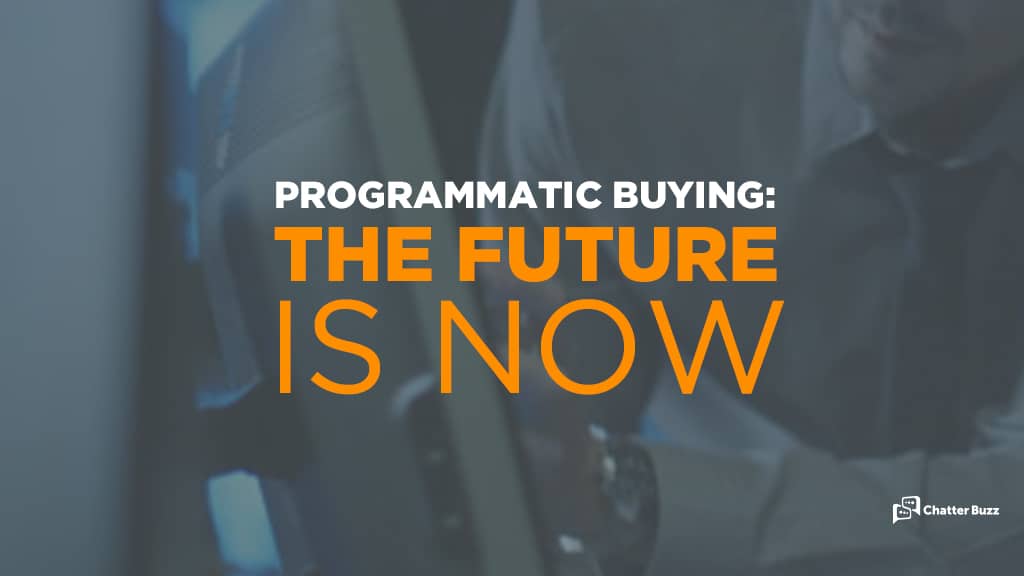Programmatic Buying: The Future is Now

If you work in advertising, you’ve probably noticed some big shifts in the last few years. The digital world, automation, and the Internet of Things have all massively changed the industry landscape.
It used to be that advertisers had a set amount of publishers (market code for entities that provide content and host advertising space) to reach out to. Now, there are not only thousands of publishers on the web, but also dozens of devices people use to access these publishers.
As an advertiser, I’m excited about the advertising possibilities this opens up—but I also recognize how difficult it can be for advertisers to decide when, where and how to display their ads.
This new climate has led to what I consider the most important advance in the advertising industry: The rise of Programmatic Buying.
It’s a complicated, technical term, but essentially programmatic buying is the automated purchasing of ad space based on algorithms and software that sort through a lot of different factors. Computers are able to study the mind-boggling complexity of advertising options available and find the best solutions. Perhaps that’s why, of the $58.6 billion invested into digital advertising this year, an estimated $14.88 billion of it went into programmatic buying, according to eMarketer.
But how does this process really work?
What is programmatic buying?
To understand the benefits of programmatic buying, we’ll have to look farther into what it is, and what it can accomplish.
As the name implies, programmatic buying occurs when a computer program bids on advertising space on behalf of a human advertiser. The program takes details of different publishers’ inventory (ad space) into account, including price, reach, type of site and more. Then, the same program can layer in audience requirements, behavioral patterns, time of day and many other aspects. The program uses all of these to find the best qualifying ad space, which the computer then purchases, usually through a process called Real Time Bidding.
There are three key components to programmatic buying.
Those are:
- Data Management Platforms, which accesses the data needed to make buying decisions
- Demand Side Platforms, where advertisers purchase ad space
- Supply Side Platforms, which helps publishers receive the fairest prices for ad space.
That’s a very simplistic view, but should help you understand the basics of how the programmatic buying system works.
What is Real Time Bidding?
Real Time Bidding is the most common method of programmatic buying. Because there are so many publishers, it would be impossible for businesses establish set standards for targeting audiences across all of them. As a result, publishers have joined together into advertising networks, and advertisers use automated bidding to purchase different ad spaces within those networks. The bidding most often goes through advertising exchanges, Demand Side Platforms or Supply Side Platforms.
In my experience, this process provides scalability for the purchase of advertising space by giving us the ability to use the same target audience characteristics across multiple publishers. Without this factor, programmatic buying couldn’t be the disruptive technology that it is.
Of course, there are also other types of programmatic buying. Those include:
- Private Marketplace, where buyers must be invited. This allows publishers to offer specific ad space to specific advertisers.
- Private Marketplace Guaranteed, where the advertiser offers ad space to one buyer, guaranteeing the buyer access.
- Automated Guaranteed, where the publisher automates its digital direct sales, usually for premium ad space.
- Spot Buying, where there is a set price, usually that has been negotiated beforehand. These deals usually occur to give advertisers more predictability.
What types of ads are available with programmatic bidding?
Up until now, programmatic buying has generally focused on direct response advertising, but it’s recently been expanding. Television has been particularly slow on the uptake, though we have seen more advertisers accessing television through this type of purchasing. In fact, at the beginning of 2015, Oreo and Ritz brand owner Mondelez programmatically purchased advertising slots during the Super Bowl.
There’s also a misconception that programmatic buying only offers remnant inventory, which translates to low quality spaces that few advertisers want. This is actually not true at all, and many premium publishers offer high quality ad space through this kind of purchasing. You can create standard website and social media display ads, along with interactive ads, video and other rich content.
Overall, I suggest using programmatic buying to stretch campaigns across multiple websites and media delivery methods.
Why is Programmatic Bidding So Useful?
First and foremost, programmatic bidding simplifies a crowded and complicated advertising world. It also allows you to track the success of your advertisement and make adjustments mid-stream. If an aspect of your ad didn’t work well—whether it’s time of day, target audience or ad size—you can change it. This way, you only invest in increasingly precise ads.
The best part is, the programmatic proxy can continue to weigh performance outcomes and adjust purchasing parameters as necessary. This frees you from tedious analytical work, while ensuring that your ad is as specialized as possible.
I predict we’ll see an increase in measurability and ROI as a result of this new strategy.
What Does Programmatic Buying Mean for Advertising?
I don’t think it’s an exaggeration to say that programmatic buying will revolutionize the advertising industry. As more and more choices become available to us, and more and more data stacks up, we must turn to automation to keep up. Programmatic buying is simply the first step into a blended advertising strategy that combines sharp advertising minds with the convenience and efficiency of programmatics.
Before that can happen, though, more advertisers and publishers will need to adopt this kind of purchasing. This means the establishment of data companies and selling agencies that can help businesses piece together all of the separate parts of programmatic buying. As the process continues to evolve, hopefully we’ll see different aspects of programmatic buying merge together into a more comprehensive, workable solution.
As soon as the technology improves and is adopted across the board, I predict we’ll see a new advertising frontier. And I, personally, can’t wait to explore it.










